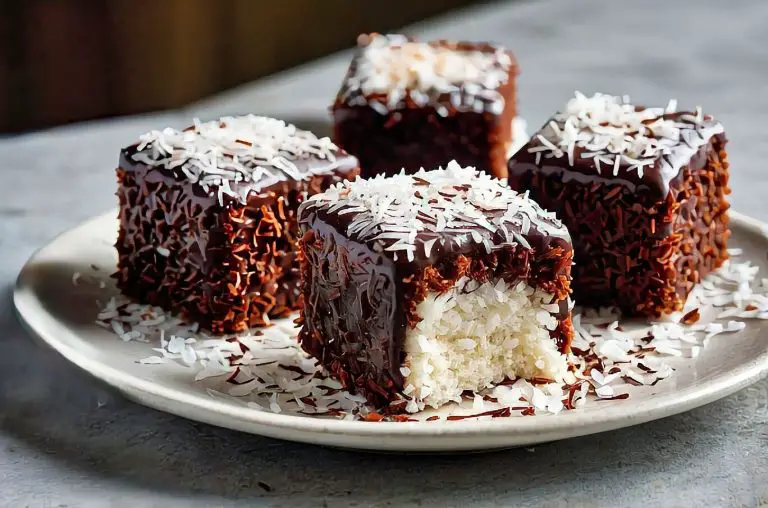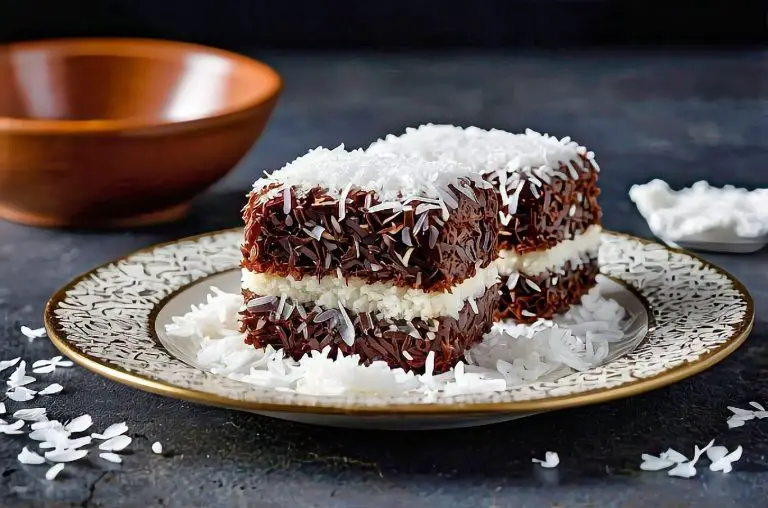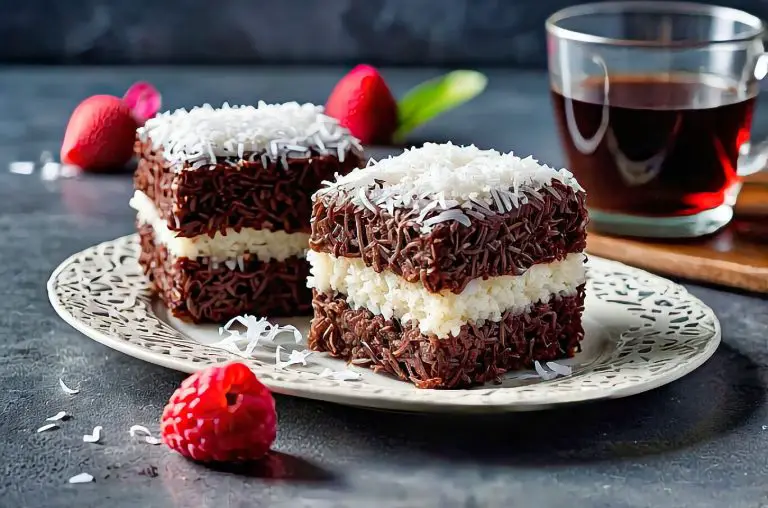The New Zealand Classic Lamingtons Recipe stand out as a delightful treat that every New Zealander loves. These sponge cakes, coated in chocolate icing and rolled in shredded coconut, bring back so many fond memories of afternoon teas and family gatherings. The simplicity of their ingredients belies the joy they bring, making them a perfect choice for both novice and experienced bakers alike.
I’m excited to share my go-to recipe for New Zealand Classic Lamingtons. It’s a straightforward process that yields delicious results, perfect for any occasion. Whether you’re hosting a get-together or simply satisfying a sweet craving, these lamingtons are sure to impress. As I walk you through each step, you’ll see just how easy it is to create this iconic dessert in your own kitchen.
History and Origin of Lamingtons
Lamingtons hold a significant place in New Zealand’s culinary heritage. Their origins are often debated, but many agree that they are integral to national celebrations and culture.
Lamingtons in New Zealand Culture
In New Zealand, lamingtons are considered a classic treat. They are commonly enjoyed at community events, including school fundraisers and charity drives, often referred to as “lamington drives.”
There’s a notable claim that lamingtons originated in New Zealand, linked to a dessert called the “Wellington,” which predates the lamington. An 1888 artwork showcases this connection, suggesting that New Zealand may indeed be the true birthplace.
The love for lamingtons is evident on occasions like National Lamington Day, celebrated on July 21 in Australia, but also embraced in New Zealand. This sweet treat represents more than just a dessert; it’s a symbol of local pride and community spirit.
Preparing the Sponge Cake
Creating the perfect sponge cake is crucial for classic lamingtons. I focus on two main steps: mixing the batter and properly baking and cooling the cake. Here’s how I do it.
Mixing the Batter
I start by preheating my oven to 180°C (356°F) and lining my cake tin with baking paper for easy removal later. In a large bowl, I combine caster sugar and eggs using an electric mixer. I beat this mixture for about 10 minutes until it becomes thick and pale, which incorporates air for a light texture.
Next, I sift in the self-raising flour and gently fold it in to maintain the airiness. I add unsalted butter, melted and cooled, and a splash of vanilla essence for flavor. The key here is to mix gently yet thoroughly, ensuring no lumps remain and everything is well combined. I want a smooth batter that’s ready for the oven.
Baking and Cooling
For baking, I pour the batter into my prepared tin and smooth the top with a spatula. I place it in the oven and let it bake for about 25-30 minutes, or until a skewer inserted in the center comes out clean. I keep a close eye—it’s essential not to overbake since that can lead to a dry cake.
Once baked, I remove it from the oven and allow it to cool in the tin for about 10 minutes. Then, I carefully lift it out using the baking paper and let it cool completely on a wire rack. This cooling process is vital, as a warm cake will be difficult to cut and coat in icing later.
Assembling and Coating the Lamingtons
Assembling and coating the lamingtons is an exciting part of the process, bringing together the cake and its delicious toppings. I’ll walk you through cutting the sponge, applying the chocolate icing, and rolling them in coconut.
Cutting and Shaping
Once the sponge has cooled completely, I carefully trim off any crusts to give the lamingtons a neat appearance. Next, I cut the sponge into squares, typically around 4 cm x 4 cm. This size is traditional and makes for a perfect bite.
Using a sharp knife ensures clean edges. I find it helpful to use a ruler for consistent sizes. After cutting, I place the squares on a wire rack, letting them air out a bit for a few minutes. This step prepares them for the icing and coating process.
Applying the Chocolate Icing
For the chocolate icing, I mix together cocoa powder, icing sugar, melted butter, and boiling water until smooth. The consistency should be thick enough to coat the sponge but not too runny.
I take each square and dip it into the icing using a large fork. The goal is to coat it evenly, allowing any excess icing to drip off back into the bowl. Sometimes I double dip for extra richness, working in batches so I don’t overcrowd my coating. Once coated, I let them rest on the rack to set slightly before rolling them in coconut.
Adding Coconut
For the final touch, I use either desiccated or shredded coconut, depending on my preference. I pour the coconut into a shallow dish for easy rolling.
Once the chocolate icing has set, I roll each lamington in the coconut, ensuring all sides are generously coated. The coconut adds texture and a delightful crunch, enhancing the overall flavor. I then transfer the coated lamingtons to an** airtight container** to keep them fresh.
These steps create that classic lamington look and taste, making them irresistible!

Variations and Serving Suggestions
Lamingtons offer a delightful base for various twists and serving ideas. I love experimenting with flavors and presentations to elevate this classic treat. Here are two delicious variations that you can easily try at home.
Raspberry Lamingtons
To make Raspberry Lamingtons, I recommend using raspberry jelly crystals mixed with hot water for a fruity coating. After creating the sponge cake, cut it into squares and dip each piece in the raspberry mixture before rolling it in desiccated coconut. This adds a tangy flavor that pairs wonderfully with the sweet sponge.
If you’re in the mood for something extra special, consider layering fresh raspberries between the sponge cake squares. The combination of the raspberry topping and the coconut creates a vibrant, indulgent treat that’s perfect for gatherings. These are especially popular at birthday parties due to their eye-catching appearance.
Lamingtons with Whipped Cream
For a rich and creamy experience, serve your Lamingtons with a generous dollop of whipped cream. I prefer using fresh, lightly sweetened whipped cream that complements the chocolate topping beautifully.
To elevate this even further, I sometimes drizzle dark chocolate over the whipped cream before serving. The contrast in textures and flavors makes for a satisfying dessert. You can also garnish with chocolate shavings or a sprinkle of jelly crystals for added flair. This makes Lamingtons a perfect choice for special occasions or a casual afternoon treat with friends.
Ingredients For the Traditional New Zealand Classic Lamingtons Recipe
Butter Sponge
Butter
Sugar
Vanilla Extract
Eggs
Flour
Baking Powder
Milk
Icing
Sugar
Cocoa Powder
Butter
Boiling Water
Coating
Coconut

Cooking Instructions For the Traditional New Zealand Classic Lamingtons Recipe
Preheat and Prepare – Preheat oven to 180°C (160°C fan) / 350°F. Sift flour and baking powder together. Grease a 20 cm x 30 cm (8″ x 12″) cake pan and line it with baking paper, leaving an overhang for easy removal.
Make the Cake – Beat butter, sugar, and vanilla with an electric mixer on medium-high until light and fluffy (1½–2 minutes). Add eggs one at a time, beating well after each to keep the batter smooth. Fold in half the flour, then stir in half the milk. Repeat with the remaining flour and milk. Pour batter into the prepared pan and bake for 25 minutes, or until a skewer inserted in the center comes out clean. Let sit for 5 minutes, then lift out using the baking paper and cool completely on a wire rack.
Prepare Cake to Coat – Cut the cake into 15 squares (5×3) or 18 rectangles. Freeze for 1 to 1.5 hours to firm up.
Icing – Combine icing ingredients in a heatproof bowl, stirring until smooth. The mixture should be syrupy but not too thin.
Coating – Place coconut in a shallow dish. Using two forks, dip each cake piece into the icing to coat fully, then roll in the coconut until covered. Transfer to a tray.
Set and Serve – Let the coated cakes sit for 1 to 2 hours until the icing sets. Serve with tea or coffee.

FAQ For the Traditional New Zealand Classic Lamingtons Recipe
Question: What ingredients are needed for a Traditional New Zealand Classic Lamingtons recipe?
A: A Traditional New Zealand Classic Lamingtons recipe typically includes sponge cake, cocoa powder, icing sugar, butter, milk, and desiccated coconut. Some variations also use raspberry jam and whipped cream for filling.
Question: How do you make a Traditional New Zealand Classic Lamingtons recipe?
A: To make a Traditional New Zealand Classic Lamingtons recipe, cut sponge cake into squares, dip each piece in chocolate icing, and coat with desiccated coconut. Allow them to set before serving. Some versions include a jam or cream filling.
Question: Can you use store-bought sponge cake for a Traditional New Zealand Classic Lamingtons recipe?
A: Yes, a Traditional New Zealand Classic Lamingtons recipe can be made with store-bought sponge cake. Using a firm sponge works best, as it holds its shape when dipped in icing.
Question: How do you prevent the sponge cake from breaking in a Traditional New Zealand Classic Lamingtons recipe?
A: To prevent the sponge from breaking in a Traditional New Zealand Classic Lamingtons recipe, chill the cake before dipping it in icing. Using a fork or skewer can also help handle the pieces gently.
Question: What is the best way to store a Traditional New Zealand Classic Lamingtons recipe?
A: A Traditional New Zealand Classic Lamingtons recipe should be stored in an airtight container at room temperature for up to three days. If filled with cream, refrigerate and consume within a day.

New Zealand Classic Lamingtons Recipe
Ingredients
Butter Sponge
- 4.5 oz Butter unsalted softened
- 1 cup Sugar caster
- 1/2 tsp Vanilla Extract
- 3 eggs room temperature
- 1 3/4 cups Flour plain/all purpose, sifted (Note 1)
- 3.5 tsp Baking Powder
- 1/2 cup Milk low or full fat
Icing
- 4 cups Sugar (icing confectionary sugar), sifted
- 1/3 cup Cocoa Powder
- 1 tbsp Butter unsalted
- 1/2 cup Boiling Water + 2 tbs
Coating
- 3 - 4 cups desiccated coconut
Instructions
- Preheat oven to 180°C (160°C fan) / 350°F. Sift flour and baking powder together. Grease a 20 cm x 30 cm (8" x 12") cake pan and line it with baking paper, leaving an overhang for easy removal.
- Beat butter, sugar, and vanilla with an electric mixer on medium-high until light and fluffy (1½–2 minutes). Add eggs one at a time, beating well after each to keep the batter smooth. Fold in half the flour, then stir in half the milk. Repeat with the remaining flour and milk. Pour batter into the prepared pan and bake for 25 minutes, or until a skewer inserted in the center comes out clean. Let sit for 5 minutes, then lift out using the baking paper and cool completely on a wire rack.
- Cut the cake into 15 squares (5x3) or 18 rectangles. Freeze for 1 to 1.5 hours to firm up.
- Combine icing ingredients in a heatproof bowl, stirring until smooth. The mixture should be syrupy but not too thin.
- Place coconut in a shallow dish. Using two forks, dip each cake piece into the icing to coat fully, then roll in the coconut until covered. Transfer to a tray.
- Let the coated cakes sit for 1 to 2 hours until the icing sets. Serve with tea or coffee.
Nutrition


3 comments
My family makes these in New Zealand when I go home to visit. Nice to make them here in my new home.
I cant believe they didnt mention the controversy over whether jam should be in the middle of a Lamington or not! Its a crucial debate in the Lamington world. What are your thoughts on this hot topic?
I cant believe they didnt mention the controversy over whether jam should be in the middle of a Lamington! Its a heated debate in my household. Whats your take on this crucial Lamington issue?